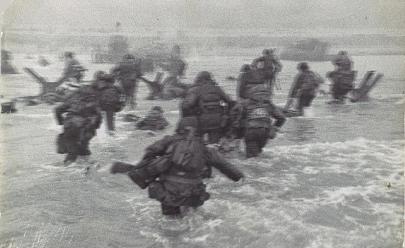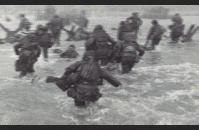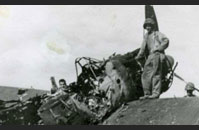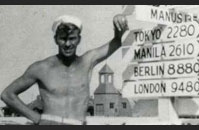THE D IN D-DAY AT A GLANCE:

Image Gallery
What Does the "D" in D-Day Mean?
This is the most frequently asked question by visitors to The National WWII Museum. Many people think they know the answer: designated day, decision day, doomsday, or even death day.
Our answer, like many answers in the field of history, is not so simple. Disagreements between military historians and etymologists about the meaning of D-Day abound. Here are just two explanations.
Stephen Ambrose’s D-Day, June 6, 1944: The Climactic Battle of World War II
Time magazine reported on June 12 [1944] that “as far as the U.S. Army can determine, the first use of D for Day, H for Hour was in Field Order No. 8, of the First Army, A.E.F., issued on Sept. 20, 1918, which read, ‘The First Army will attack at H-Hour on D-Day with the object of forcing the evacuation of the St. Mihiel salient.'" (p. 491)
In other words, the D in D-Day merely stands for Day. This coded designation was used for the day of any important invasion or military operation. For military planners (and later historians), the days before and after a D-Day were indicated using plus and minus signs: D-4 meant four days before a D-Day, while D+7 meant seven days after a D-Day.
Paul Dickson’s War Slang, quoting Robert Hendrickson’s Encyclopedia of Word and Phrase Origins
Many explanations have been given for the meaning of D-Day, June 6, 1944, the day the Allies invaded Normandy from England during World War II. The Army has said that it is “simply an alliteration, as in H-Hour.” Others say the first D in the word also stands for “day,” the term a code designation. The French maintain the D means “disembarkation,” still others say “debarkation,” and the more poetic insist D-Day is short for “day of decision.” When someone wrote to General Eisenhower in 1964 asking for an explanation, his executive assistant Brigadier General Robert Schultz answered: “General Eisenhower asked me to respond to your letter. Be advised that any amphibious operation has a ‘departed date’; therefore the shortened term ‘D-Day’ is used.” (p.146)
Brigadier General Schultz reminds us that the invasion of Normandy on June 6, 1944 was not the only D-Day of World War II. Every amphibious assault—including those in the Pacific, in North Africa, and in Sicily and Italy—had its own D-Day.
Download a printable version of this At A Glance
TAKE ACTION:


EDUCATION PROJECTS:
Student Travel – WWII Educational Tours
High school and college students, learn the leadership principles that helped win WWII on a trip to France or during a weeklong residential program in New Orleans. College credit is available, and space is limited.
See You Next Year! HS Yearbooks from WWII
Collected from across the United States, the words and pictures of these yearbooks present a new opportunity to experience the many challenges, setbacks and triumphs of the war through the eyes of America’s youth.
The Victory Gardens of WWII
Visit the Classroom Victory Garden Project website to learn about food production during WWII, find lesson plans and activities for elementary students, get tips for starting your own garden and try out simple Victory Garden recipes!
The Science and Technology of WWII
Visit our new interactive website to learn about wartime technical and scientific advances that forever changed our world. Incorporates STEM principles to use in the classroom.
Kids Corner: Fun and Games!
Make your own propaganda posters, test your memory, solve puzzles and more! Learn about World War II and have fun at the same time.






